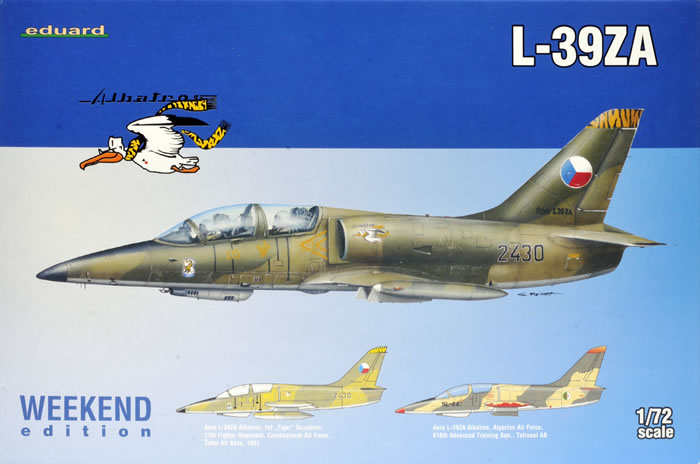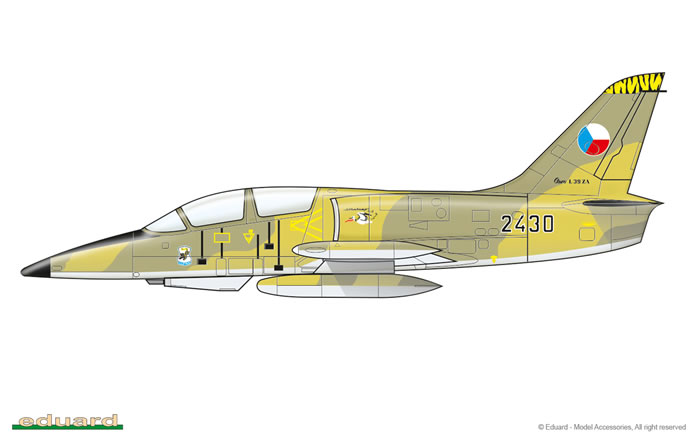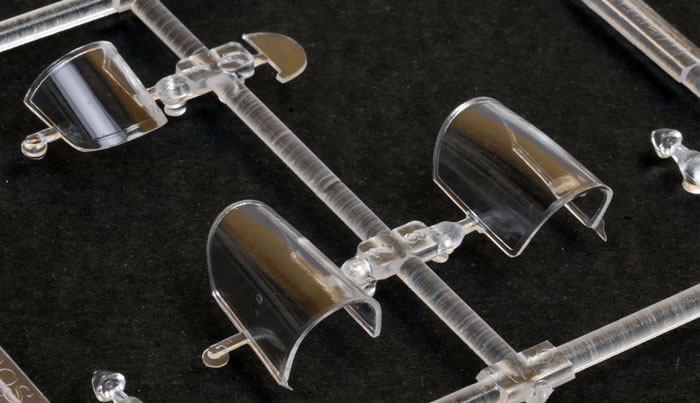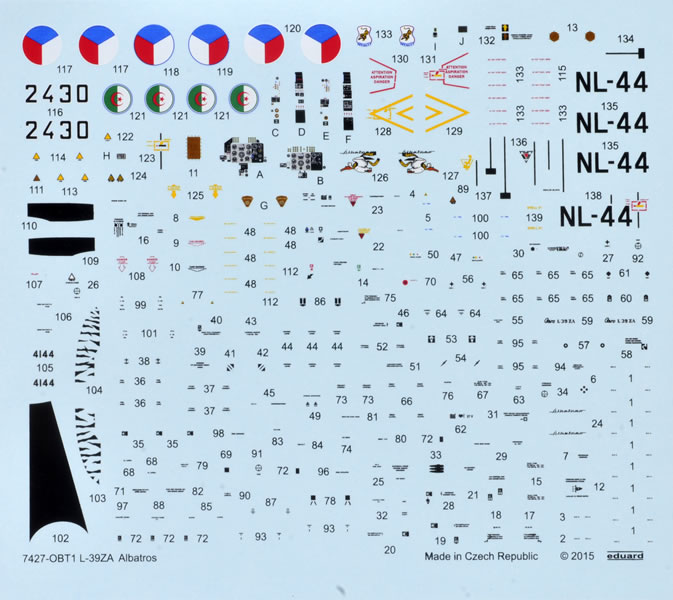|
L-39ZA

Eduard Weekend Edition, 1/72 scale
S
u m m a r y |
| Catalogue Number: |
Eduard Kit No.7427 - L-39ZA (Weekend Edition) |
| Scale: |
1/72 |
| Contents and Media: |
57 grey & 6 clear styrene parts, plus decal for two subjects. |
| Price: |
US$16.95 or US$14.41 for BFC Members plus shipping,
available online from Eduard
Click for currency conversion. |
| Review Type: |
FirstLook |
| Advantages: |
A very nice kit; well detailed, with a most comprehensive decal sheet, and tremendously good value. |
| Disadvantages: |
Rather bland ejection seats. |
| Conclusion: |
Eduard’s L-39 kits are very good quality, with fine detail, and a good reputation for ease of construction; they come with a very comprehensive decal sheet and are probably amongst the least expensive 1/72 jet trainer kits available.
To say that the review kit represents great value is an understatement. Its only weak point is the rather bland ejection seats, but these can easily be enhanced for only a few dollars more with Eduard’s Super Fabric seatbelts.
This kit is such good value, that even the above minor criticism seems a little unfair, I have no hesitation in highly recommending it. |
Reviewed by Mark Davies

Eduard's 1/72 L-39ZA Weekend Edition is available online from Squadron.com
The Aero L-39 Albatros is a high-performance jet trainer aircraft developed in Czechoslovakia to meet requirements for a "C-39" (C for cvi?ný – trainer) during the 1960s to replace the L-29 Delfín as the main training aircraft. It was the first of the second-generation jet trainers, and the first turbofan-powered trainer produced, and was later updated as the L-59 Super Albatros and as the L-139 (prototype L-39 with Garrett TFE731 engine).

A further development of the design, the L-159 ALCA, began production in 1997. To date, more than 2,800 L-39s have served with over 30 air forces around the world. The Albatros is the most widely used jet trainer in the world; in addition to performing basic and advanced pilot training, it has also flown combat missions in a light-attack role. Atypically, it has never received a NATO reporting name.

The L-39ZA is a significantly upgraded L-39ZO intended for armed training and light attack. It employs sturdier landing gear, has a higher payload (total 1,290 kg), and provision for a GSh-23L 23-millimeter twin-barreled cannon attached in a conformal pod under the cockpit, having a 150-round magazine within the airframe. Outer pylons are wired to carry K-13 or R-60 air-to-air missiles. Two prototypes first flew in September 1976, and 208 L-39ZA’s have since been delivered.
Contents
The parts come in a top-opening box and are enclosed in resealable cellophane bags.
As far as I can tell, the sprues are shared in common with Eduard’s other L-39 releases. These currently include Weekend Editions of the L-39C and L-39ZO, and a Profipack L-39C. The Profipack Edition includes coloured PE details, four decal options, and a canopy & wheel mask (this may now be a Kabuki tape item, but Eduard’s website image shows vinyl example). The Profipack Edition’s instructions can be viewed here.
The review kit’s instructions are in Eduard’s Weekend Edition format, which convey the same assembly information as the Profipack Edition’s, but are printed on less glamorous paper. The review kit’s instructions include a parts map, well drawn assembly diagrams, colour-printed painting & markings guide, and two pages detailing stencil placement. The review kit’s instructions can be viewed or downloaded as a PDF.
As with most recent Weekend Edition kits, two decal options are now offered rather than a single subject as was previously the case. However, whereas other recent Weekend Editions I have examined also included Eduard’s Super Fabric seat-belts, this release does not; although they can be purchased separately.
The Kit
Although now 13 years old, the kit immediately creates a positive impression due to its delicate surface detail, fine small parts and clean mouldings. Being one of Eduard’s earlier kits, the major parts lack locating pins (except for the horizontal stabiliser); although none are really needed in my opinion.
Eduard’s more recent releases rival Tamiya for moulding crispness and levels of detail, whereas the review kit could stand muster without too much cause for embarrassment with, for example, a Hasegawa kit dating from the same period. This said, the Japanese product would have locating pins throughout and perhaps be just a tad crisper in detail definition.
The parts count is modest and the breakdown conventional for the type.
The cockpit is generally well catered for. The instrument panels and side-consoles have raised detail and the option of adding decals with instrument face details. The ejection seats are four-piece items offering a reasonable shape, but lacking in detail. Frankly they are the cockpit’s weakest point given the size and clarity of the canopy parts. What a pity Super Fabric seat-belts were not included as they are with the Weekend Editions of the MiG-15 and Bf 110C kits. Of course there is also the option of buying the coloured PE detail set for the L-39ZA, but at the very least I recommend buying the Super Fabric seatbelts to dress up the cockpit for a closed canopy model.
In addition to the cockpit, the fuselage encloses an engine compressor face, turbine and tailpipe. No mention is made of a need for nose ballast, but I would suggest erring on the side of caution and include some. Then there are just the air intakes, wing and horizontal stabiliser to add to have an almost complete airframe.

The undercarriage is simplicity itself. In fact, I was reminded of the old Frog Gannet kit where the undercarriage legs are fixed place adjacent to closed wheel wells. But whereas the Frog kit was inaccurate on this point, Eduard are quite correct with their L-39kit, as the real aircraft encloses its wheel-wells when the undercarriage is extended; as these links to images of the main and nose gear illustrate.
The kit includes the integral GSh-23L 23-millimeter twin-barrelled cannon, plus underwing stores consisting of drop-tanks and two rockets or missiles I cannot identify. It seems a bit of a pity that K-13 or R-60 air-to-air missiles were not included as this is a feature that sets the ZA variant apart from other L-39’s.
The kit apparently builds very well going by what I have read online and in magazines, so I do not anticipate any constructional problems. I did read of one builder who found the ejection seats need some slight trimming to fit the cockpit tub however.
An interesting point identified by Phil Parsons in his review of Eduard’s L-39C Weekend Edition here on HyperScale in 2012 concerned the kit’s depiction of the elevators. Apparently, L-39’s on the ground with the control lock applied have their elevators raised, whereas the kit’s is moulded in the neutral position. This should be is fairly easy to accomplish if you wish to accurately depict a parked L-39.
Markings
The kit provides for tow markings choices, these being:
- “2430”of 1st “Tiger “Squadron, 11th Fighter Regiment, Czech Air Force, Zatec Air Base, 1991.
- NL-44 of 618th Advanced Training Squadron, Algerian Air Force, Tafraoui Air Base.

The decals are produced to Eduard’s usual very high standards and appear to be excellent in all respects. The decal sheet includes extensive stencilling, an antiglare panel for the nose, and wing-walk markings. My past experience with the brand suggests that they should perform very well.
Eduard’s L-39 kits are very good quality, with fine detail, and a good reputation for ease of construction. They come with a very comprehensive decals sheet and are probably amongst the least expensive 1/72 jet trainer kits available. To say that they represent great value is an understatement. This latest issue of the L-39ZA will be welcomed by those wanting a more aggressive cannon-toting derivative that can also carry air-to-air missiles (a pity these were not included).
Whilst I am not familiar with the other the brand L-39 kits I have mentioned, I will stick my neck and say that I would be surprised if Eduard’s were not the best in 1/72 scale. They are certainly the most readily available, and superior to the other most commonly offered L-39 kit by Kovozávody Prostejov and its re-boxing by several other brands.
First released 13 years ago, Eduard’s kit still holds up well as an example of modern tooling with fine detail, although Eduard have since “raised the bar” several times with more recent releases of other subjects. The only weak point is the kit’s rather bland ejection seats, but these can easily be enhanced for only a few dollars more with Eduard’s Super Fabric seatbelts.
This kit is such good value, that even the above minor criticism seems a little unfair, I have no hesitation in highly recommending it.
Thanks to Eduard for the sample
Review Text Copyright © 2015 by Mark Davies
Page Created 23 April, 2015
Last updated
23 April, 2015
Back to HyperScale Main Page
Back to Reviews Page |
